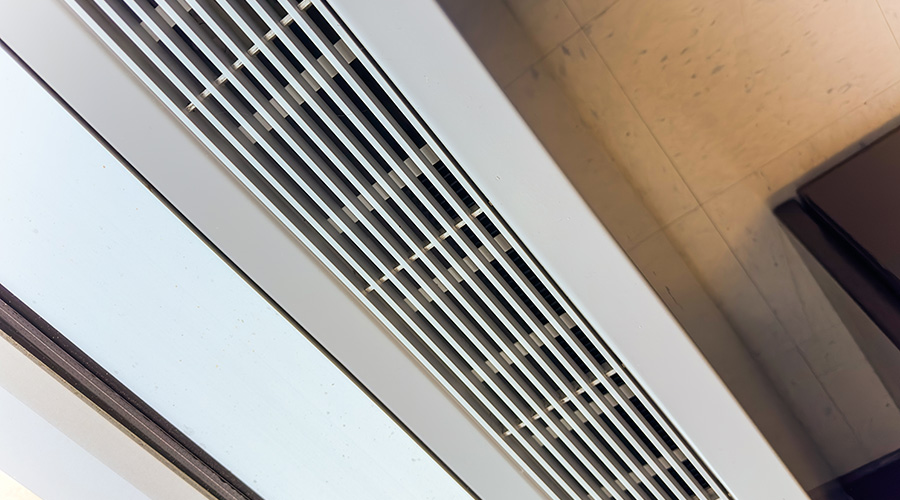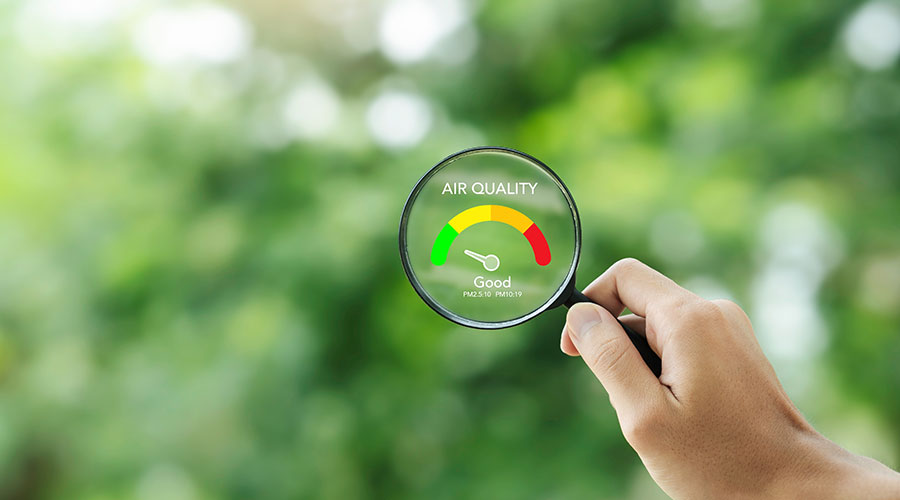The Inside Story on Clean Indoor Air
The demand for healthy indoor environments continues to grow as building occupants become more sophisticated about the effects of airborne contaminants. In many institutional and commercial facilities, air filters play a central role in protecting occupant health against molds, bacteria, viruses, dust, chemicals and odors.
The challenge for maintenance and engineering managers is to understand the impact of advances in these products as they relate to their facilities and to develop strategies that meet specific challenges of their particular facilities.
Filtration Insights
Air filters use four particle-attachment methods:
- straining, which involves trapping particles in spaces between filter fibers
- impingement, or the collision with a fiber
- interception, where a fiber traps larger particles by inherent adhesive force
- diffusion, where very small particles act like gases and adhere to fibers.
Because air-filter media vary widely, managers should begin the selection process with air-quality tests to determine existing contaminants and their sizes. Typical indoor air quality (IAQ) tests for each zone in a commercial facility include the following:
- thermal environmental analysis for temperature and relative humidity
- aerobiology for airborne particulates
- surface microscopy for surface particulates
- allergen for screening dust allergens and formaldehyde.
Managers receive test results in degrees, percents and counts, or micrograms per cubic meter. Counts include: temperature; relative humidity — temperatures lowered go along with increased relative humidity, which might be a mold source; opaque particles; skin-cell fragments; inert biodetritus; fibers; pollen; formaldehyde; allergens; and mold.
Filtration Advances
The average human breathes in about 16,000 quarts of air each day, and each quart contains about 70,000 particles, according to the U.S. Environmental Protection Agency (EPA) and most particles are about 3 microns or smaller. The agency also has found that indoor air is two-five times more contaminated than outdoor air.
Recent advances in air filtration have produced cleaner, purer air and fewer IAQ problems. For example, a medium-efficiency, pleated filter often is the best filter choice for general applications in buildings. Manufacturers of pleated air filters used in HVAC systems incorporate a range of materials, or media, including fiberglass, polyester, cotton, paper and synthetic non-woven materials. Synthetic media — rather than traditional, woven cotton-polyester media — offer improved performance for the investment.
New polyolefin fibers can resist both shedding — allowing pollutants to get back into the air stream — and moisture absorption, which means less growth of bacteria. New fibers don’t use chemical binders, so the presence of humidity does not lead to degradation.
These fibers also maintain higher efficiency over longer periods, and manufacturers can electrostatically charge them for higher initial efficiency and greater attraction to smaller particles. Electrostatic filtration using attraction of oppositely charged particles requires a less dense media and translates into better energy efficiency.
Foam-filter manufacturers have introduced oils that, applied to the filters, enhance their efficiency.
Matching Products to Needs
Many case studies demonstrate that a well-administered IAQ program can cut costs related to cleaning, mold remediation and energy, to name just a few saving sources. The best way to lower costs related to improving indoor air quality is to stop airborne contaminants before they enter a facility — in other words, filtering the supply air to the facility with the right type and efficiency filter media that is properly sealed on installation. Filtering and cleaning return air and reusing it also helps control heating costs.
ASHRAE has established standard testing methods — ASHRAE Standard 52.2 — for classifying filter media according to efficiency. Using the standard’s methods, managers can compare all filtration media and slot them into categories as a way of streamlining the process of selecting the most appropriate filter for an application.
(For more information on filter type and efficiency, see the chart below)
Filter Type and Efficiency
The ASHRAE Test 52.2 outlines the minimum efficiency reporting value (MERV) ratings. Efficiency and particle size are:
| MERV |
Efficiency |
Particle Size |
| 1-4 |
<20% |
>10 micron |
| 5-8 |
<20-35% |
3.0 to 10.0 micron |
| 9-12 |
40-75% |
1.0 to 3.0 micron |
| 13-16 |
80->95% |
0.3 to 1.0 micron |
| |
99.97-99.9999% |
0.3 micron (HEPA) |
| |
99.9999% |
0.1 to 0.2 micron particle (ULPA) |
|
Filters with less than 20 percent efficiency include disposable panel, automatic-roll media, and permanent metal. The 20-40 percent efficiency category includes cube, pleated panel, and ring-panel filters. The 40-95 percent category includes extended-surface pocket and rigid-cell filters. High-efficiency particulate air (HEPA) and ultra-low particulate air (ULPA) filters fall into the 99.97-99.9999 percent efficiency category.
While extremely efficient, HEPA and ULPA filters require very careful handling during installation to prevent damage, due to the fragile nature of the microfiber media.
Facility Specifics
Particles larger than 10 microns are found in all facilities and tend to be the easiest to filter. These contaminants include some pollen, dust mites, sanding dust, spray-paint dust, and carpet and other textile fibers. Facilities typically use disposable, washable, latex-coated animal hair, foam or synthetic-panel filters, or passive self-charging woven polycarbonate panel filters.
Despite these similarities, facilities of different types have very specific issues.
Medical buildings. These facilities offer some of the most difficult air-filtration challenges for maintenance and engineering managers. Besides being very people-intensive facilities, they contain many patients who are at risk because they are ill and might have weakened immune systems. Also, bodily fluids in areas such as operating rooms, intensive care units, labs and patient rooms must be kept from human contact.
Hospital labs use bag filters 12-36 inches deep, with six to twelve pockets or box filters for contaminant particles 1-3 microns in size, such as Legionella, nebulizer drops, and dust from humidifiers.
Hospitals typically use bag and box filters for inpatient-care, general-surgery, and smoking areas with particles that are 0.3-1 microns. For clean rooms, orthopedic surgery units, and areas with carcinogenic materials, radioactive materials, and virus contaminants, where particles are less than or equal to 0.30 micron, hospitals often use HEPA or ULPA filters.
Education buildings. About 20 percent of K-12 schools are sub-par in air quality. Complicating this situation is the fact that education facilities are characterized by very high-density traffic. Classrooms in which students are in close proximity need frequent air changes to prevent the transfer of mold, bacteria, viruses, dust and odors. Chemistry labs present specialized challenges, depending on the chemicals present.
Typical contaminants in these buildings are mold, spores, hair spray, fabric protector, dusting aids, copier toner, face powder, smoke, and sneeze-droplet nuclei. Most contaminants are in the 3.0-10.0 micron range. Filters typically used to remove them include pleated filters, 1-5 inches thick, with cotton-polyester media, cube or pocket cartridge filters, or disposable fiberglass-panel filters.
Legionella or humidifier dust measuring 1-3 microns require bag or box filters, 12-36 inches deep and 6-12 inches deep, respectively. Smoke, sneeze droplets and copier toner tend to measure 0.3-1 microns and require bag or box filters with microfine fiberglass or synthetic media.
Mold growth, resulting from leaks, high humidity levels, and condensation around windows, remains a major problem in schools. In such cases, building occupants might complain about odors, skin irritations, allergies or asthma.
In some cases, toxins with more serious consequences can develop. Many education facilities have suffered maintenance neglect for years, and these deferred repairs have aggravated the problem. Some schools have closed for emergency mold remediation as administrators and school boards become more aware of the health dangers associated with mold.
In other cases, citizens have brought lawsuits against school districts related to serious mold problems in order to obtain a satisfactory solution. Removing long-standing mold growth often requires expensive repairs, such as removing walls and cleaning buildings with HEPA-filtered vacuums.
Commercial office buildings. These buildings usually are not as high-density as medical and education buildings, and they are less likely to have traffic in and out all day. But they are occupied for long periods by the same employees who make contact with the surroundings over the entire day or evening or on nighttime shifts.
Typical contaminants in these buildings are similar to education facilities: mold, spores, hair spray, fabric protector, dusting aids, copier toner, face powder, smoke, droplet nuclei from sneezing. Most of the contaminants measure 3-10 microns. Specifiers can effectively remove them by using:
- pleated filters, 1-5 inches thick, with cotton-polyester media
- cube or pocket cartridge filters
- disposable fiberglass panel filters.
Legionella or humidifier dust, measuring 1-3 microns, require bag or box filters, 12- 36 inches deep and 6-12 inches deep, respectively. Smoke, sneeze droplets and copier-toner particles measuring 0.3-1 microns require bag or box filters.
Filtration Retrofits
The process of upgrading an air-filtration system to improve IAQ requires that managers act both carefully and completely. If air-quality tests show that a building requires more efficient filters in certain areas, managers will need to remember that increased efficiency comes at a price. That price might be loss of airflow, energy efficiency or air balance with respect to adjacent areas of a building.
For example, field tests of motor phases comparing amps under load to full-load nameplate rating might reveal that motors have unused capacity, as well as that the higher air flow is within the blower’s range.
Managers might be able to obtain added airflow to compensate for higher efficiency by changing the sheave ratios on the air-handling equipment. If not, managers might need to consider a complete change of blower, motor and controls. After the upgrade, managers should schedule an air balancing of the building to ensure that the installation meets code requirements for that type of facility.
Resources on Air Filtration
|
Related Topics:











